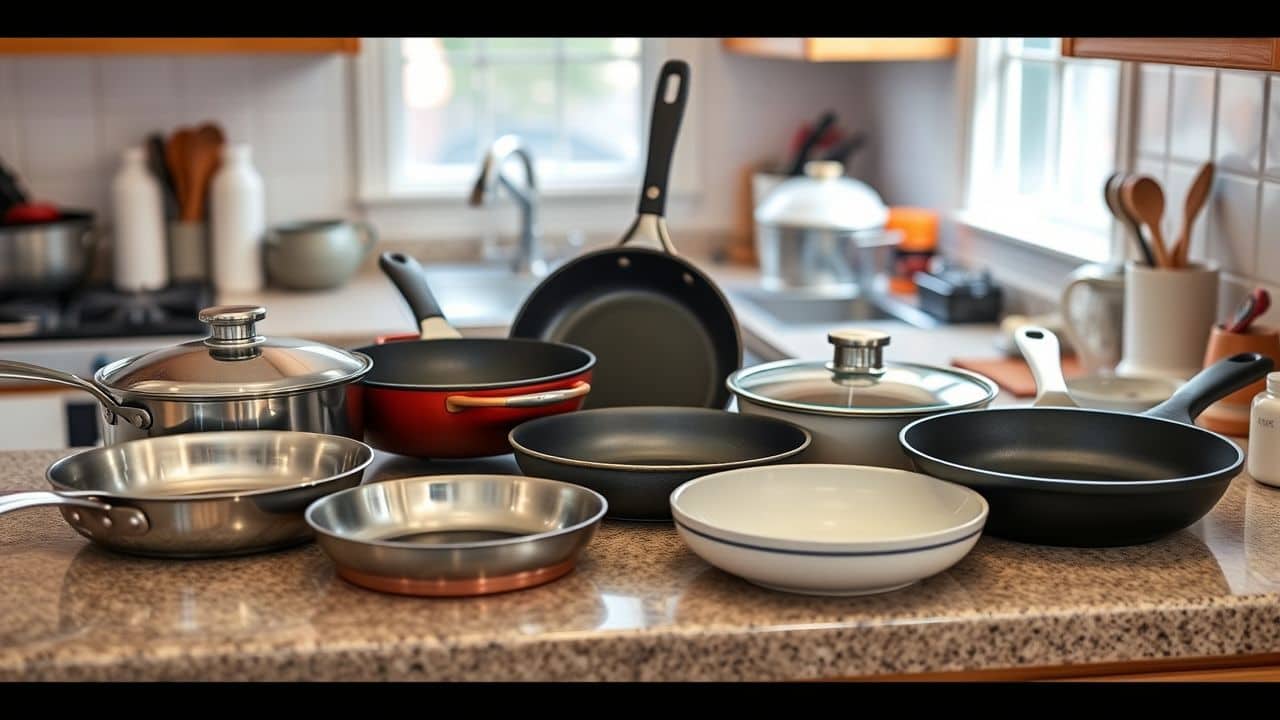Are you tired of burnt meals and sticky pans? Choosing the right frying pan can make or break your cooking. Did you know there are six main types of frying pans? This guide will help you pick the best pan for your needs.
Ready to upgrade your kitchen game?
Key Takeaways
Six main frying pan materials are stainless steel, non-stick, cast iron, ceramic, copper, and hard nitriding.
Stainless steel pans are durable, heat evenly, and work on all stovetops. They can be tricky to cook with at first but last for years with proper care.
Non-stick pans make cooking and cleanup easy, but need replacing every 12–18 months. Some worry about health risks from coatings.
Cast iron pans hold heat well and become naturally non-stick over time. They need special care but can last for generations.
Copper pans heat fast and evenly, but are pricey ($200-$1000+) and need regular polishing. They don’t work on induction stoves.
Table of Contents
Exploring Popular Frying Pan Materials
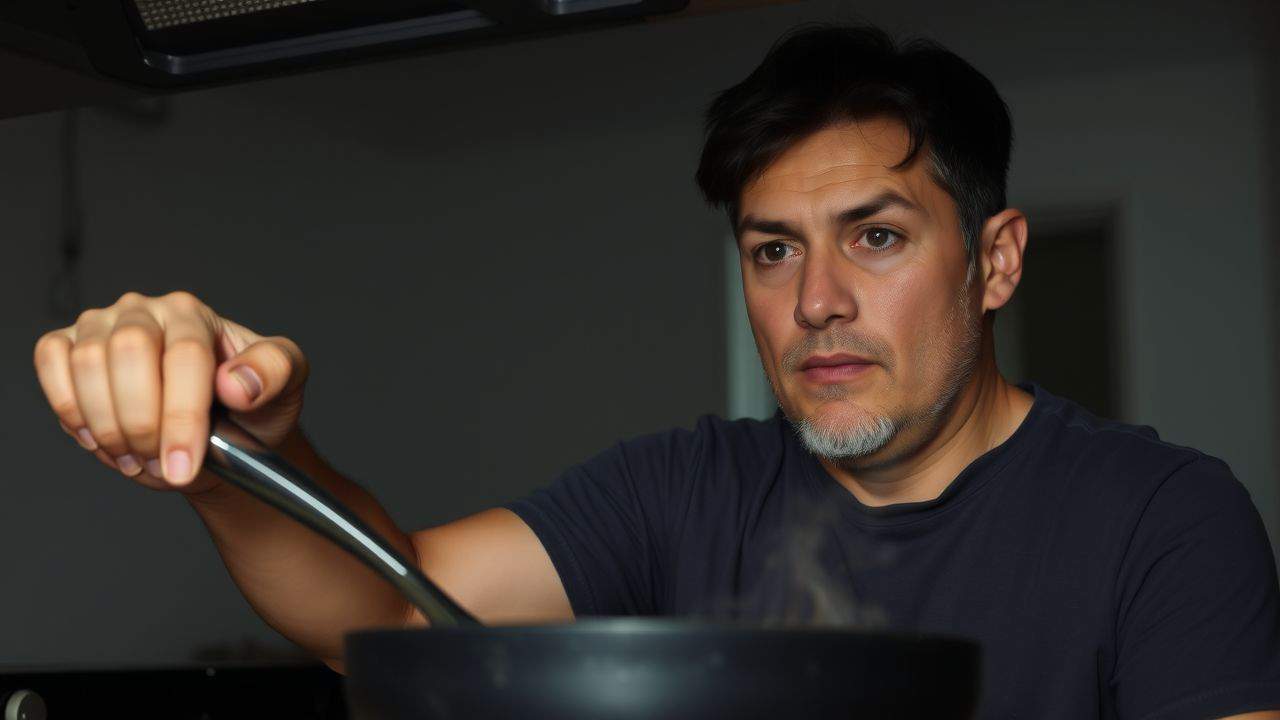
Ever wonder why chefs swear by certain pans? It’s all about the material. Let’s explore six types of frying pans that can make or break your cooking game.
Stainless Steel Features
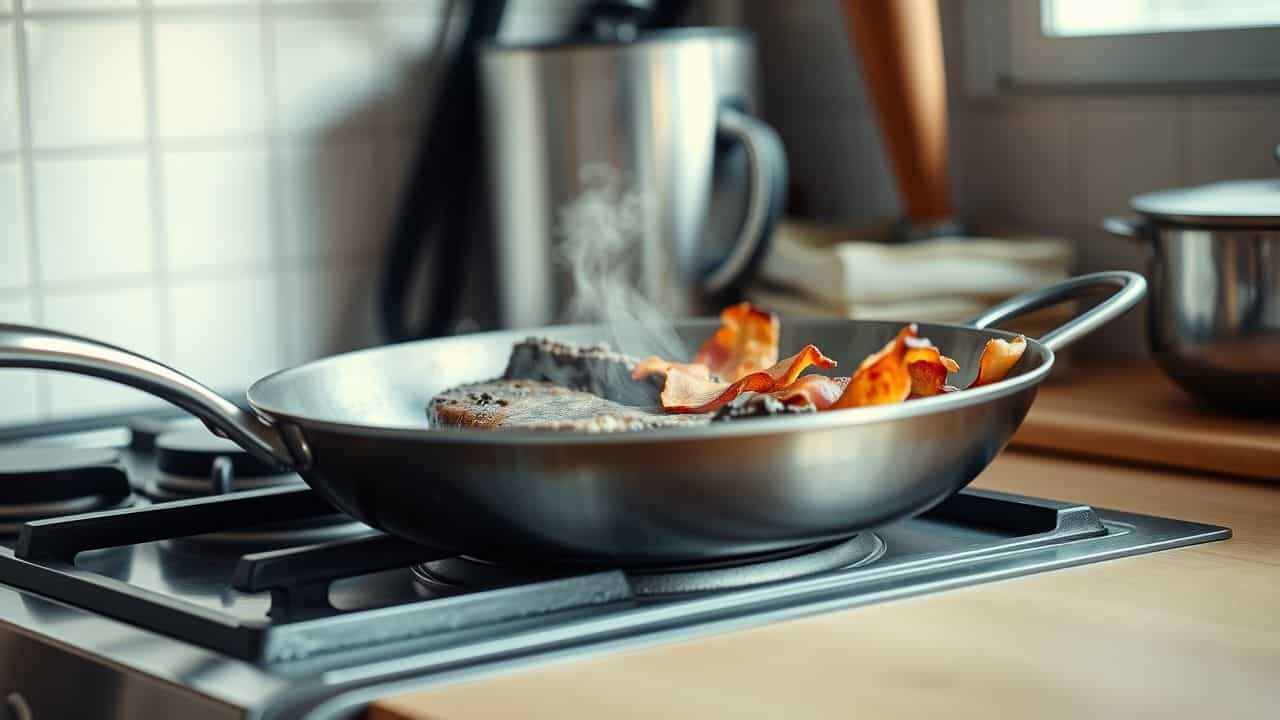
Stainless steel pans pack a punch in the kitchen. They’re tough as nails, thanks to their mix of chromium and nickel. These metals fight off rust and keep the pan looking sharp. I’ve used my stainless steel pan for years, and it still shines like new.
It can take high heat like a champ, perfect for searing steaks or frying up some crispy bacon.
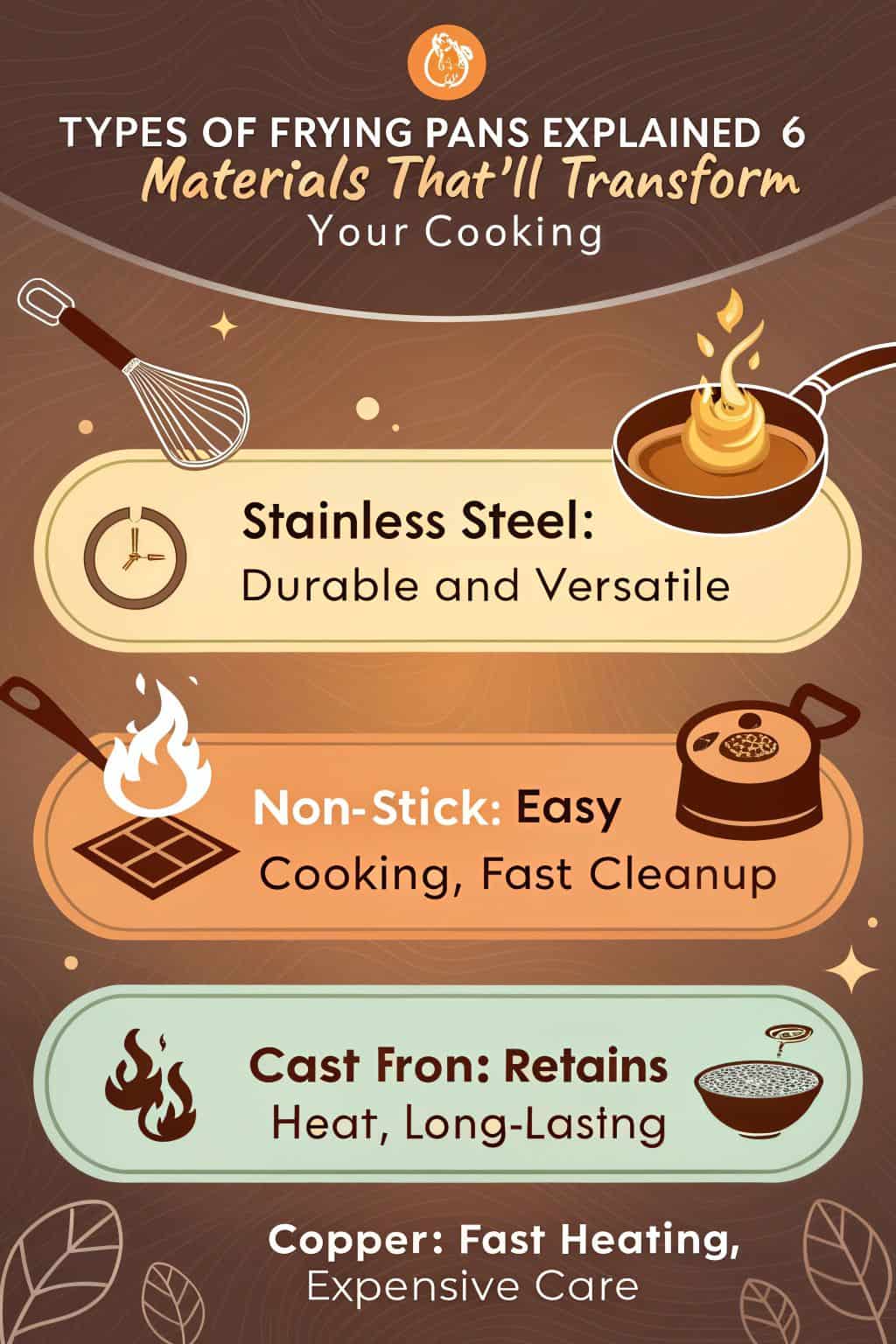
But that’s not all. Stainless steel spreads heat evenly, so no more burnt spots on your food. It’s also non-reactive, meaning acidic foods won’t pick up a metallic taste. I love whipping up tomato sauces in my 10-inch stainless clad frying pan.
Want to buy this pan? You won’t regret it. These pans are built to last and can handle any cooking job you throw at them. Let’s move on to the benefits of non-stick pans.
Stainless steel is the Superman of cookware – tough, versatile, and always ready for action.
Non-Stick Benefits
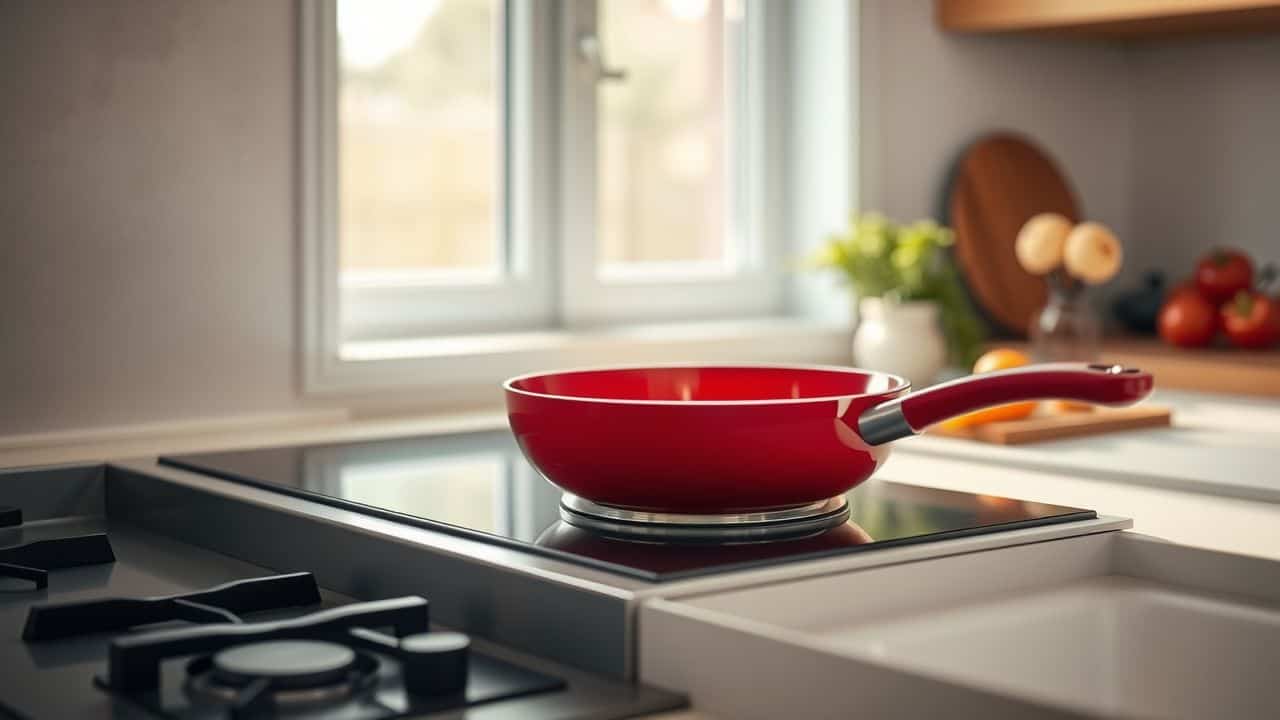
Moving from stainless steel, let’s talk about non-stick pans. These kitchen heroes make cooking a breeze. No more stuck-on messes or burnt disasters. Non-stick pans let you cook with less oil, perfect for health-conscious guys.
They’re great for eggs, fish, and other delicate foods. You won’t need to scrape and scrub after meals. Clean-up is quick and easy.
https://www.youtube.com/watch?v=NzNx_q9IpvI&pp=ygUJI3BhbnR5cGVz
Non-stick pans come in different types. PTFE-coated pans work well up to 400°F. Ceramic-coated ones claim to be healthier and chemical-free. Hard-anodized aluminum pans spread heat evenly.
These pans are ideal for reheating leftovers too. A good non-stick pan costs about $140, often on sale for less. With proper care, they’ll serve you well in the kitchen for years.
Cast Iron Properties
Moving from non-stick pans, let’s talk about cast iron. This kitchen workhorse packs a punch. Cast iron pans hold heat like champs. They can take temps up to 1200°F without breaking a sweat.
That’s hotter than your oven can go! These pans are tough cookies too. With proper care, they’ll outlast most of your other cookware.
But cast iron isn’t just about brawn. It’s got brains too. A well-seasoned pan develops its own non-stick surface. No fancy coatings needed here. Just good old-fashioned cooking know-how.
I’ve had my cast iron skillet for years. It’s my go-to for steaks, cornbread, and even campfire cooking. Sure, it needs a bit more TLC than other pans. But trust me, the flavor it adds to food is worth every second of care.
Ceramic Attributes
From cast iron, we move to a lighter option: ceramic pans. These pans offer a modern twist on non-stick cooking. Ceramic cookware has a natural non-stick surface. This means you can cook with less oil, making meals healthier.
The smooth surface also makes cleanup a breeze.
Ceramic pans shine in the kitchen. They spread heat well and cook food evenly. Plus, they’re free from chemicals like PTFE. This makes them a safe choice for health-conscious cooks.
As one chef puts it:
Ceramic pans are like the Swiss Army knife of cookware – versatile, safe, and easy to use.
However, ceramic isn’t perfect. These pans may chip if dropped. They also don’t last as long as other materials. But for many, the pros outweigh the cons.
Copper Characteristics
Copper pans shine in the kitchen. They conduct heat like a champ, spreading it fast and even. This means your food cooks just right, every time. Pros love copper for tricky dishes that need exact temps.
But copper isn’t cheap. These pans can cost you $200 to over $1,000. That’s a big chunk of change for most home cooks.
Copper needs some extra care, too. Many copper pans have a stainless steel lining inside. This makes them tougher and easier to clean. But if your pan has a tin lining, you might need to get it fixed up now and then.
Also, copper won’t work on those fancy induction stoves. Still, for guys who love to cook, copper pans are hard to beat. Next up, let’s talk about how to pick the right pan for your needs.
Benefits and Drawbacks of Stainless Steel Frying Pans
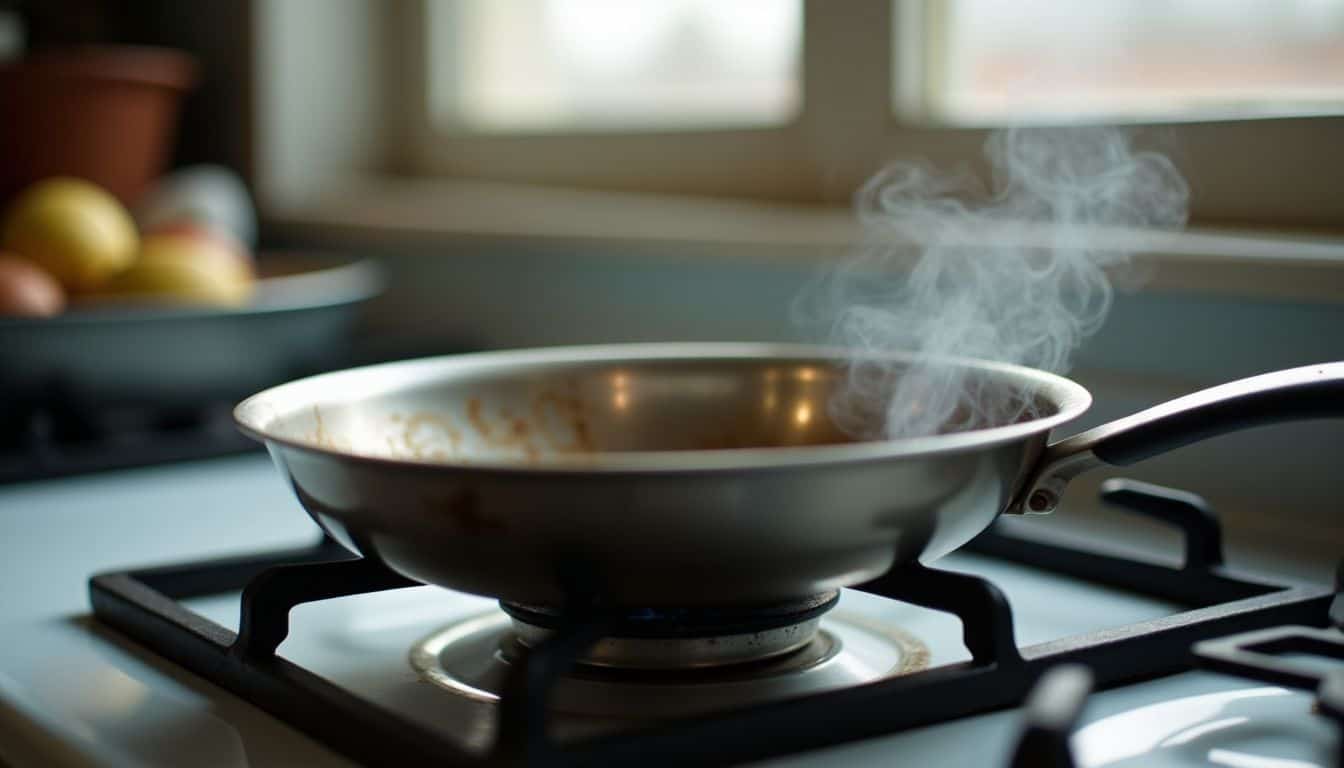
Stainless steel frying pans are tough cookies in the kitchen. They can take a beating and still look great, but they’re not always the easiest to cook with.
Advantages of Stainless Steel
Stainless steel frying pans pack a punch in the kitchen. They’re tough as nails and can take a beating. These pans heat up fast and spread the heat evenly, so your food cooks just right.
You can use them on any stovetop, even induction. Plus, they’re a breeze to clean – just toss them in the dishwasher.
Men love these pans because they’re low-maintenance. No need to baby them or worry about scratches. They won’t rust or react with acidic foods. The 3-ply build makes them great heat conductors.
Stainless steel: the Superman of cookware.
At 10 inches, they’re perfect for cooking most meals. Whether you’re searing a steak or making a stir-fry, stainless steel’s got your back.
Stainless Steel Considerations
Stainless steel pans have a few drawbacks to consider. They can stick to food, making cooking challenging at times. You’ll need to use more oil or butter to prevent this. Also, these pans don’t spread heat as well as some other types.
This means you might get hot spots that cook food unevenly. With practice, you can overcome these issues.
Caring for stainless steel pans is relatively straightforward. Soap and a sponge will suffice for most cleaning jobs. Avoid the dishwasher though – it can damage the pan over time.
For tough stains, try a mix of vinegar and baking soda. It’s highly effective! Lastly, preheat your pan and use enough oil. This will help create a non-stick surface and make your cooking easier.
Advantages and Limitations of Non-Stick Frying Pans
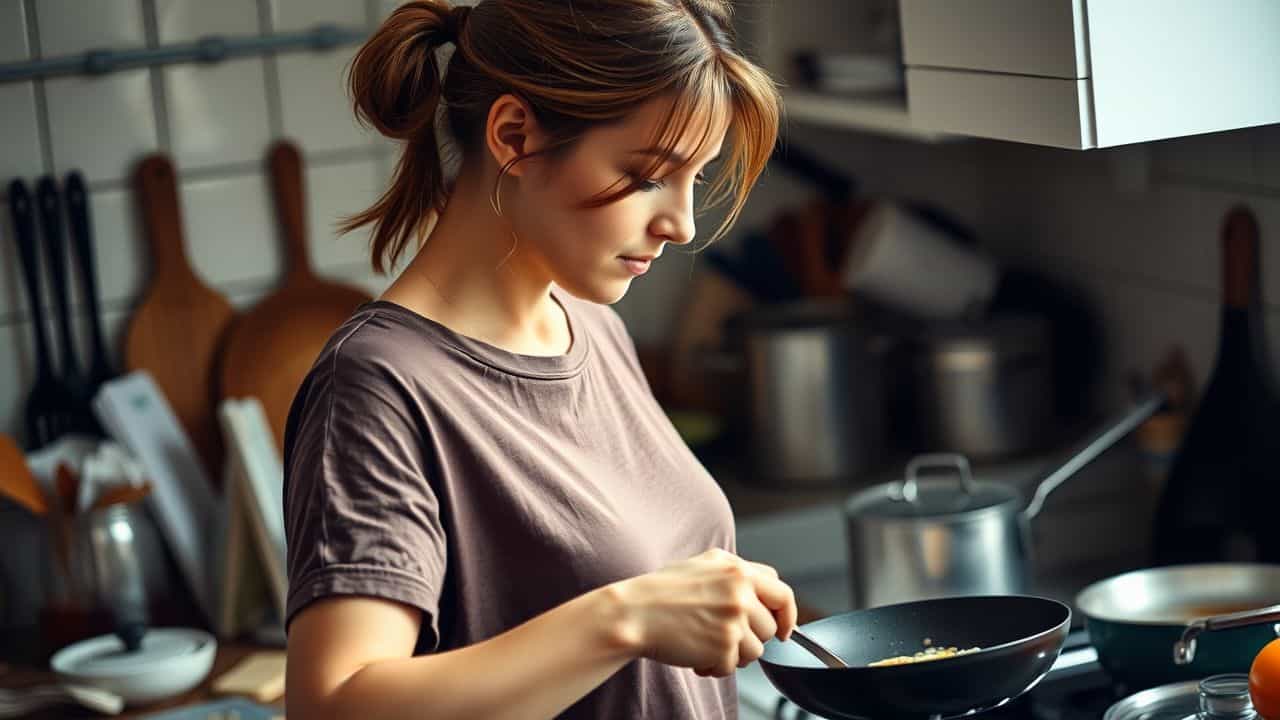
Non-stick pans make cooking a breeze. They let you fry with less oil and clean up fast, but they have some downsides too.
Benefits of Non-Stick
Non-stick pans make cooking a breeze. They let you fry eggs without them sticking to the bottom. You can flip pancakes with ease. Cleanup is a snap too. Just wipe the pan with a soft cloth, and you’re done.
No more scrubbing or soaking for hours.
https://www.youtube.com/watch?v=DdpXbrPj0GQ
These pans shine when cooking delicate foods. Fish won’t fall apart when you try to move it. Cheese won’t turn into a gooey mess that’s hard to clean. PTFE Teflon is the most common non-stick surface.
It’s slick and tough. Some newer pans use ceramic coatings instead. They claim to be more eco-friendly. Either way, you’ll use less oil and butter in your cooking. That’s great for your waistline and your wallet.
Non-Stick Pan Considerations
Non-stick pans have a short life. You’ll need to replace them every 12 to 18 months. This can add up fast. Scratches and peeling on the coating are signs it’s time for a new pan. To make them last, wash by hand.
Don’t use harsh soaps or scrubbers.
Some folks worry about health risks from non-stick coatings. PFCs in these pans raise concerns. But you can find safer options now. Look for pans free of PFOA and PTFE. They cost more but might ease your mind.
Always follow the maker’s care tips to keep your non-stick pans in top shape.
A good pan is a cook’s best friend, but a scratched non-stick is nobody’s pal.
Features of Cast Iron Frying Pans
Cast iron pans pack a punch in the kitchen. They’re tough as nails and hold heat like a champ, making them perfect for searing steaks or frying up some crispy chicken.
Cast Iron Advantages
Cast iron pans pack a punch in the kitchen. These tough guys can take the heat and keep on cooking. They hold onto warmth like a champ, making sure your food stays hot. Plus, they’re not picky eaters – they work on any stove, even induction.
The best part? A well-seasoned pan becomes naturally non-stick over time.
But wait, there’s more! These pans aren’t just for cooking. They’re like a secret health booster. When you cook in cast iron, a bit of iron seeps into your food. It’s like getting a free iron supplement with every meal.
And if you’re looking for size, the 11-inch Made In Red pan fits the bill perfectly. It’s big enough for family meals but not so huge it takes over your stove.
Considerations for Cast Iron
Cast iron pans need some TLC. They can rust if not cared for right. Acidic foods like tomatoes or wine can strip off the seasoning. You’ll want to avoid cooking these in your cast iron.
Also, skip boiling water in it. Cleaning takes a bit of work too. You might need to scrub with salt or use a chain mail tool to get stuck-on bits off.
These pans are heavy. Your arms will get a workout just lifting them. They cost more than other types too. I saw one priced at 170 LTL, down from 195 LTL. That’s a 13% discount, but still pricey.
Despite these drawbacks, many cooks swear by cast iron. The flavor it adds to food is hard to beat.
Qualities of Ceramic Frying Pans
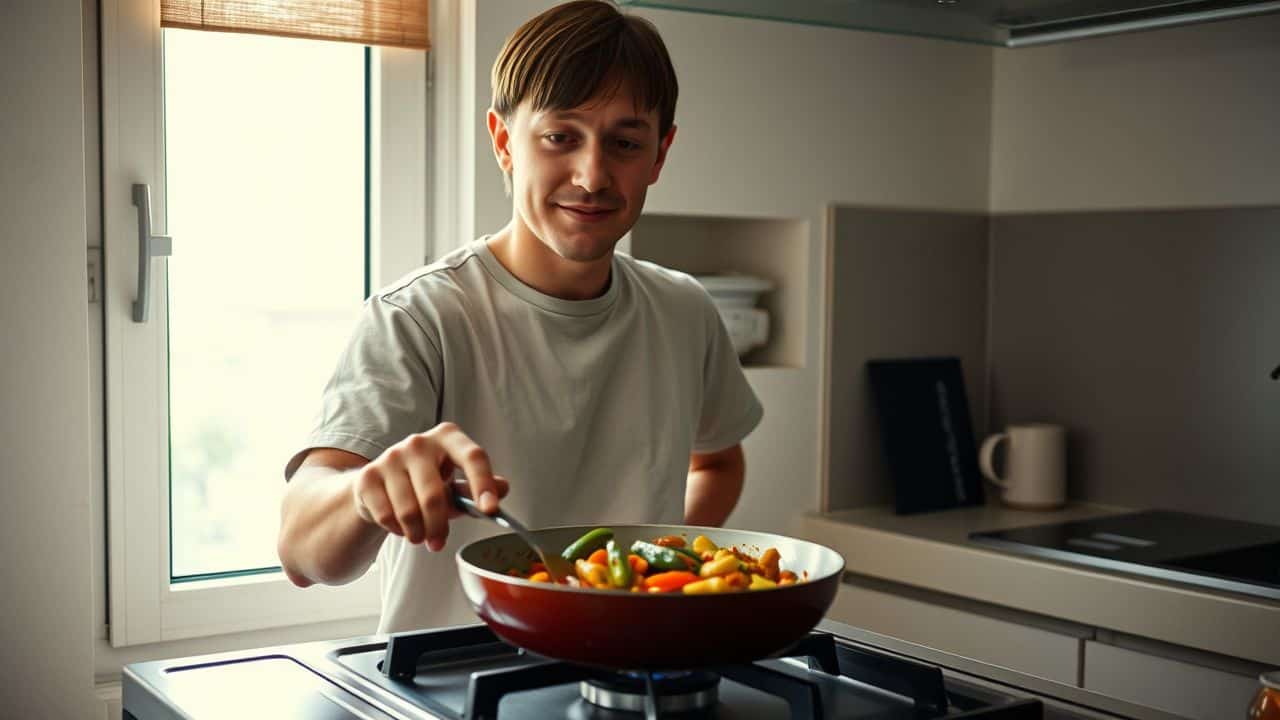
Ceramic frying pans offer a slick surface without harmful chemicals. They heat up fast and spread warmth evenly, making them great for quick meals.
Ceramic Benefits
Ceramic pans bring a lot to the table. They offer a slick surface without harmful chemicals. Food slides off easily, so you can cook with less oil. I’ve found these pans great for making perfect omelets.
They work on most stoves and clean up’s a breeze. Many are safe for the dishwasher, too. Plus, they come in cool colors to jazz up your kitchen.
But there’s more to ceramic than just looks. These pans heat up fast and spread the heat evenly. This means no more burnt spots on your pancakes. They’re also tough enough to handle high heat without warping.
Now, let’s look at some things to keep in mind with ceramic cookware.
Ceramic Pan Considerations
Ceramic pans need gentle care. They can chip or crack if you’re not careful. Don’t use metal tools on them. Stick to wooden or silicone utensils instead. These pans also don’t like the dishwasher.
Hand wash them to keep them in good shape. The non-stick surface won’t last forever. It will wear down over time, especially if you use high heat often.
Heat spread can be an issue with ceramic pans. They might not cook food evenly. This can lead to hot spots and uneven cooking. Some guys find they need to move food around more in these pans.
On the plus side, ceramic pans look great in the kitchen. They come in many colors and styles. Next, let’s look at copper frying pans and what they bring to the table.
Copper Frying Pans: Pros and Cons
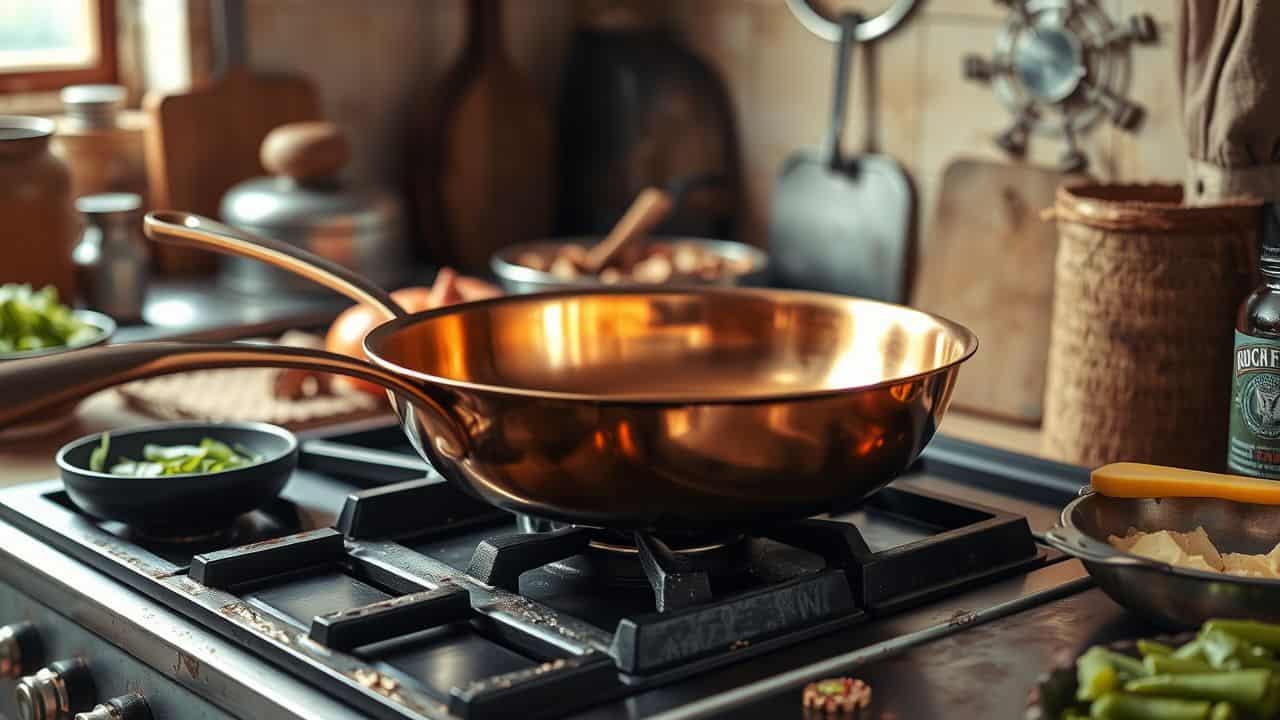
Copper pans are the rock stars of the kitchen. They heat up fast and spread the heat evenly, making your food cook like a dream. But watch out – these shiny beauties need some TLC to keep them looking good and working well.
Advantages of Copper
Copper pans shine in the kitchen. They heat up fast and spread warmth evenly. This means your food cooks just right, every time. I’ve used copper pans for years, and they make cooking a breeze.
You can control the heat with ease, perfect for tricky dishes like sauces or fish. Plus, these pans look great hanging in your kitchen. They add a touch of class to any cookspace.
Durability is another big plus for copper cookware. With proper care, these pans can last for generations. I still use my grandfather’s copper skillet, and it works as well as ever.
The elegant design of copper pans also makes them great for serving dishes straight from the stove. Your guests will be impressed by both the taste and look of your meals.
Considerations for Copper
While copper pans shine in the kitchen, they come with a few snags. These pots can set you back a pretty penny, costing anywhere from $200 to over a grand. That’s a big chunk of change for most home cooks.
I once splurged on a fancy copper pan, and boy, did my wallet feel it!
Copper also needs some TLC. You’ll have to polish it often to keep it looking good. And if you cook acidic foods like tomatoes, watch out. The metal can react and mess with your dish’s taste.
Plus, if you’ve got an induction stove, these pans won’t work. Lastly, some copper pans have tin lining that might need fixing over time. It’s not all bad news, but these points are worth chewing on before you buy.
Hard Nitriding (Nitrogen Infused) Frying Pans
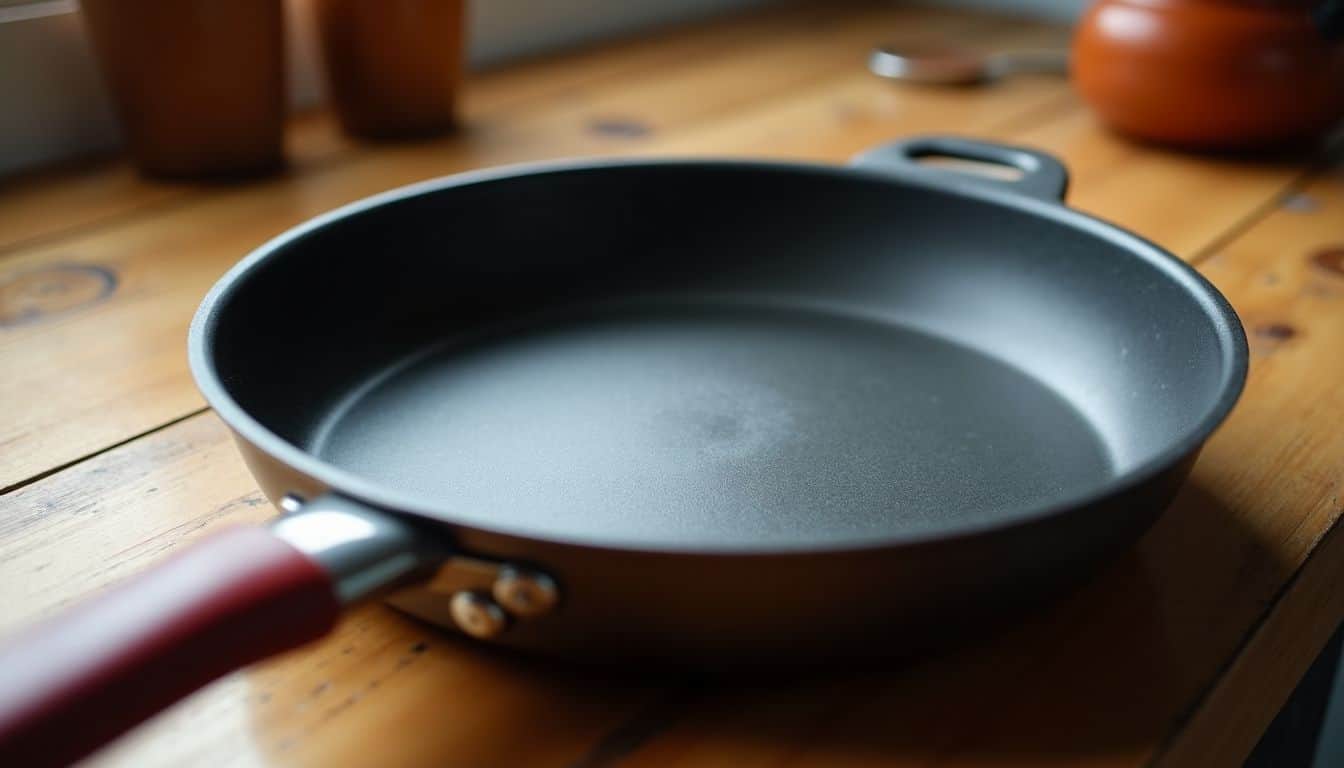
Hard nitriding pans pack a punch in the kitchen. These tough guys use nitrogen to create a super-hard surface that laughs in the face of scratches and wear.
Benefits of Nitrogen-Infused Surface
Nitrogen-infused surfaces pack a punch in the kitchen. These pans boast a tough-as-nails exterior that laughs in the face of scratches and wear. I’ve used one for months, and it still looks brand new.
The secret lies in the nitrogen-infused cast iron process. This method creates a pan that spreads heat like a champ, ensuring your food cooks evenly every time.
But that’s not all, folks. These pans come pre-seasoned, so you can start cooking right away. No need to fuss with complicated prep work. The surface is naturally non-stick, making cleanup a breeze.
And get this – some brands even market these pans as future family heirlooms. Talk about a gift that keeps on giving!
Hard Nitriding Considerations
Hard nitriding pans have some drawbacks to think about. The smooth finish can make food stick more than other non-stick surfaces. Also, the silicone handle that comes free with these pans can’t go in the oven.
This limits how you can use the pan for certain recipes. The heat-treating process makes the pan tough, but it may not work well on all stove types.
When picking a frying pan, it’s smart to weigh all your options. Let’s look at how to choose the right pan for your kitchen next.
How to Select the Appropriate Frying Pan

Picking the right frying pan can make or break your cooking game. Think about what you cook most and how often you’ll use it before you buy.
Assessing Cooking Needs
Picking the right frying pan starts with knowing your kitchen habits. Think about what you cook most often. Do you fry eggs daily? Or do you whip up stir-fries for the family? Your go-to meals will guide your choice.
Size matters too. A 12-inch pan works great for feeding four people. But if you’re cooking solo, a smaller pan might do the trick.
Your stove type plays a big role too. Not all pans work on all stoves. Induction cooktops need special pans. Gas stoves heat differently than electric ones. Don’t forget about weight and care.
Heavy pans are tough to flip food in. Some need hand washing, while others are dishwasher safe. If you’re just learning to cook, start with an all-purpose pan.
As your skills grow, you can add more specialized tools to your kitchen arsenal.
Maintenance and Care Tips
Keeping your pans in top shape is key to great cooking. Soap and a soft sponge are your best friends for most pans. Skip the dishwasher, even if the label says it’s okay. Hand washing will make your pans last longer.
For stubborn bits on cast iron, try scrubbing with salt or a chain mail tool. This method is surprisingly effective!
Each pan type needs its own care routine. Stainless steel benefits from a mix of soap, vinegar, and baking soda for a deep clean. Non-stick pans need gentle handling – no metal tools allowed! Ceramic pans are tough, but they don’t do well with metal utensils and harsh detergents.
A well-cared-for pan is a chef’s best pal in the kitchen.
People Also Ask
What are the main types of frying pans?
The big six in the frying pan world are non-stick, cast iron, carbon steel, stainless steel, aluminum, and copper. Each has its own superpowers in the kitchen. Non-stick pans are slick operators, while cast iron skillets are tough as nails. Carbon steel pans are the new kids on the block, and stainless steel is the jack-of-all-trades. Aluminum pans heat up faster than you can say “dinner’s ready,” and copper pans are the fancy pants of the bunch.
How do I pick the right frying pan for my cooking style?
It’s like finding your kitchen soulmate. If you’re all about easy cleanup, non-stick pans are your best bet. For searing steaks or making cornbread, cast iron skillets are the way to go. Carbon steel pans are great for stir-frying and sautéing. Stainless steel pans can handle just about anything you throw at them. Aluminum pans are perfect for quick, even cooking. And if you want to impress your guests, break out the copper pans.
Can I use metal utensils on all types of frying pans?
Hold your horses! Not all pans play nice with metal. Non-stick pans will throw a fit if you use metal on them. Stick to wooden or silicone utensils for these delicate flowers. Cast iron and carbon steel pans are tough cookies and can handle metal. Stainless steel, aluminum, and copper pans are also metal-friendly, but be gentle to avoid scratches.
How do I care for my frying pans to make them last longer?
Treat your pans right, and they’ll be your kitchen BFFs for life. Non-stick pans need gentle handwashing. Cast iron and carbon steel pans love a good seasoning now and then. Stainless steel pans can take a beating but still prefer handwashing. Aluminum pans are low-maintenance, while copper pans need a bit of TLC to keep their shine. Remember, no matter the pan, avoid sudden temperature changes – they’re not fans of thermal shock!
Can I use all types of frying pans on any stovetop?
Not so fast! Some pans are picky about where they heat up. Non-stick, stainless steel, and aluminum pans are usually cool with any stovetop. Cast iron and carbon steel pans work on most stovetops but might scratch glass tops. Copper pans can be divas and may not play nice with induction cookers. Always check the manufacturer’s instructions before you fire up the stove.
Are there any health concerns with different types of frying pans?
Let’s talk turkey. Non-stick pans have gotten a bad rap due to PFAS, but newer ones are safer. Cast iron pans can add a smidge of iron to your food – a bonus for some folks. Copper pans should have a lining to prevent copper from leaching into food. Stainless steel, carbon steel, and aluminum pans are generally safe bets. The key is to use and care for your pans properly. When in doubt, chat with your doc about any specific health worries.
References
https://cookingissues.com/2010/02/16/heavy-metal-the-science-of-cast-iron-cooking/ (2010-02-16)
https://www.cooksdirect.com/fry-pan-materials-guide?srsltid=AfmBOopzGY8f0GyhLBtb8quhosVso89KHcGE3-jhK1INgZOMQgYdL8j2 (2022-02-11)
https://madeincookware.com/blogs/how-to-pick-the-best-frying-pan-material-for-you (2024-05-13)
https://www.leafscore.com/eco-friendly-kitchen-products/stainless-steel-cookware-pros-cons/ (2024-05-29)
https://dalstrong.com/blogs/news/stainless-steel-cookware
https://castey.com/en/advantages-and-disadvantages-of-non-stick-coatings-on-frying-pans/
https://nourishevolution.com/when-to-use-nonstick-pans-and-when-not-to/
https://www.healthline.com/nutrition/cast-iron-cooking-2 (2022-05-19)
https://madeincookware.com/blogs/ceramic-cookware-pros-and-cons
https://www.carawayhome.com/blog/pros-cons-ceramic-cookware
https://prudentreviews.com/copper-cookware-pros-cons/ (2023-09-20)
https://www.seriouseats.com/buying-copper-cookware
https://www.kitchenkapers.com/pages/cookware-materials-and-why-they-matter
https://ciweteofficial.com/blogs/news/how-to-choose-the-right-frying-pan-a-comprehensive-guide (2024-05-29)
https://rockingham.ces.ncsu.edu/2023/05/picking-pans-quick-guide-to-cookware-materials/ (2023-05-12)
